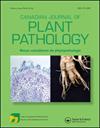胡萝卜根茎腐病镰刀菌的鉴定及致病性
IF 1.5
4区 农林科学
Q3 PLANT SCIENCES
引用次数: 0
摘要
自2015年以来,法国胡萝卜种子作物中经常观察到镰刀菌引起的坏死。2016年至2019年期间,从胡萝卜的病变中收集了53株镰刀菌分离株。基于ACL1、RPB2和EF1-α部分基因序列的宏观和微观形态鉴定和分子分型结果确定了两个主要类群,分别为22株F. avenaceum和22株F. tricinctum。此外,还鉴定出3株禾状镰刀菌,2株尖孢镰刀菌和2株尖锐镰刀菌,1株索拉尼镰刀菌。木霉(T. atroviride和T. harzianum)和镰刀菌(F. tricinctum分离物FT001和F. avenaceum分离物FA002)的双重培养未显示木霉具有任何抗生素能力。分离菌株FT001和FA002对两种杀菌剂和一种天然产物的体外敏感性相似,其药效取决于活性成分。Prothioconazole + tebuconazole比fluyram + trifloxystrobin更有效(FT001的菌丝生长减少97%,FA002的菌丝生长减少99.8%)(菌丝生长分别减少58%和56%)。葱提取物似乎是一种很有前途的杀菌剂替代品,因为它们几乎与原硫康唑+戊康唑一样有效。用三种胡萝卜病分离株(FT001、FA002和F. graminearum FG001)人工接种硬粒小麦诱导植株坏死。结果表明,胡萝卜种子作物镰刀菌病原菌可能会传播到小麦上,而小麦通常与胡萝卜轮作。本文章由计算机程序翻译,如有差异,请以英文原文为准。
Characterization and pathogenicity of Fusarium spp. isolates causing root and collar rot on carrot
Abstract Since 2015, necrosis caused by Fusarium spp. has been regularly observed in carrot seed crops in France. A collection of 53 Fusarium isolates was gathered from lesions on carrot between 2016 and 2019. Morphological characterization at both the macroscopic and microscopic levels and molecular typing based on the ACL1, RPB2 and EF1-α partial gene sequences resulted in the identification of two main groups, corresponding to 22 F. avenaceum and 22 F. tricinctum isolates. In addition, three isolates of F. graminearum, two each of F. oxysporum and F. acuminatum, and one isolate of F. solani were also identified. Dual cultures of Trichoderma spp. (T. atroviride and T. harzianum) and Fusarium spp. (F. tricinctum isolate FT001 and F. avenaceum isolate FA002) did not indicate any antibiosis capabilities of Trichoderma. The in vitro sensitivity of isolates FT001 and FA002 to two fungicides and one natural product was similar, with an efficacy depending on the active ingredient. Prothioconazole + tebuconazole was more effective (mycelial growth reduced by 97% for FT001 and 99.8% for FA002) than fluopyram + trifloxystrobin (mycelial growth reduced by 58% and 56%, respectively). Allium extracts seemed to be a promising alternative to fungicides, since they were almost as efficient as prothioconazole + tebuconazole. Artificial inoculation of durum wheat using three isolates from carrot lesions (FT001, FA002 and F. graminearum FG001) induced plant necrosis. This result suggests that Fusarium pathogens of carrot seed crops may be transmitted to wheat, which is commonly used in rotation with carrot.
求助全文
通过发布文献求助,成功后即可免费获取论文全文。
去求助
来源期刊
CiteScore
4.50
自引率
5.00%
发文量
56
审稿时长
6-12 weeks
期刊介绍:
Canadian Journal of Plant Pathology is an international journal which publishes the results of scientific research and other information relevant to the discipline of plant pathology as review papers, research articles, notes and disease reports. Papers may be submitted in English or French and are subject to peer review. Research articles and notes include original research that contributes to the science of plant pathology or to the practice of plant pathology, including the diagnosis, estimation, prevention, and control of plant diseases. Notes are generally shorter in length and include more concise research results. Disease reports are brief, previously unpublished accounts of diseases occurring on a new host or geographic region. Review papers include mini-reviews, descriptions of emerging technologies, and full reviews on a topic of interest to readers, including symposium papers. These papers will be highlighted in each issue of the journal and require prior discussion with the Editor-in-Chief prior to submission.

 求助内容:
求助内容: 应助结果提醒方式:
应助结果提醒方式:


